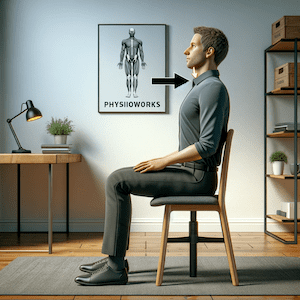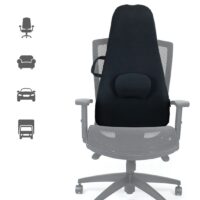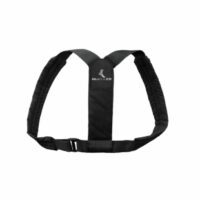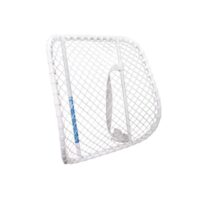Posture Exercises
Article by John Miller


Posture Exercises
The Importance of Posture Exercises: A Physiotherapist’s Guide
As a physiotherapist, I often encounter clients suffering from poor posture-related issues, ranging from back pain to impaired breathing. Fortunately, proper posture exercises can significantly alleviate or prevent these problems.
Understanding Posture
Posture, the way we position our bodies while sitting, standing, or moving, is crucial for health. Proper posture ensures our muscles and bones align correctly, enhancing movement efficiency and balance. Conversely, poor posture can cause muscle fatigue, strain, and pain.
Common Posture Problems
- Rounded Shoulders: Common among desk workers.
- Forward Head Posture: Often results from leaning forward, especially while using electronic devices.
- Lower Back Pain: Usually linked to weak core muscles and prolonged sitting.
Posture Exercises
Disclaimer
While these posture exercises are beneficial for improving posture, it’s important to approach them with caution, especially if you’re new to physical activity or have existing health concerns. Listen to your body and avoid pushing into pain. If you experience discomfort or uncertainty about performing these exercises, it’s advisable to consult a physiotherapist or healthcare professional for guidance. Remember, each individual’s body is unique, and exercises should be tailored to meet your specific needs and capabilities.
Chin Tuck
- Maintain a straight spine while sitting or standing.
- Gently draw your chin inwards.
- Hold for 5 seconds, then release.
- Repeat 10 times.
Chest Stretch
- Stand or sit straight.
- Clasp hands behind your back.
- Lift arms gently, opening the chest.
- Hold for 20-30 seconds.
Shoulder Blade Squeeze
- Sit or stand tall.
- Squeeze shoulder blades together.
- Hold for 5 seconds, then release.
- Perform 10-15 repetitions.
Wall Angel
- Stand with your back against a wall.
- Press arms, elbows, and wrists against the wall.
- Slide arms up and down, like making snow angels.
- Do 10-15 repetitions.
Tips for Maintaining Good Posture
- Be Mindful: Regularly check and correct your posture.
- Stay Active: Engage in exercises to strengthen posture-related muscles.
- Ergonomics: Organise your workspace to support good posture. Read more: Workstation Setup
- Stretch Regularly: Prevent muscle stiffness through flexibility exercises.
Recent Research and Additional Advice
Recent studies underline the importance of dynamic movements and core-strengthening exercises in enhancing posture. Incorporating activities like yoga and Pilates, known for their posture-correcting benefits, can offer additional support. Furthermore, awareness of posture during everyday activities, like walking and lifting, is equally important. Regular consultations with a physiotherapist can provide tailored exercises and guidance, ensuring optimal posture health. Remember, investing in your posture is investing in your overall health.
Conclusion
Incorporating these posture exercises into your daily routine can significantly improve your posture. Good posture goes beyond appearance; it’s vital for your physical health and well-being. If persistent pain or difficulty arises, seeking personalised advice from a physiotherapist is crucial. Your posture, directly influenced by daily habits, can improve immensely with small, consistent changes.
Rochedale - Call 38410277
Book Online: RochedaleSalisbury - Call 32751044
Book Online: SalisburySandgate - Call 32691122
Book Online: SandgateArticle by John Miller
Posture FAQs


Your Guide to Better Posture
Maintaining good posture is crucial for overall health and well-being. Poor posture can lead to a host of issues, including back pain, reduced mobility, and even long-term health problems. This FAQ page addresses common questions about posture, providing insights and tips to help you improve your posture and enhance your quality of life.
Why is Good Posture Important?
Good posture helps you stand, walk, sit, and lie in positions that place the least strain on supporting muscles and ligaments. It keeps bones and joints in correct alignment, reducing the risk of injury and discomfort. Learn more about the benefits and reasons for maintaining good posture in the following articles:
- Why Posture Matters: Discusses the significance of good posture and its impact on overall health.
- Health Benefits of Good Posture: Explains the various health benefits of maintaining correct posture.
- Posture and Pain Prevention: Highlights how good posture can prevent common aches and pains.
How to Improve Your Posture?
Improving your posture involves strengthening the muscles that support your spine and developing new habits for standing, sitting, and lying down. Here are some practical steps and exercises to help you improve your posture:
- Posture Exercises: A list of exercises specifically designed to improve posture.
- Tips for Better Posture: Practical tips and techniques to incorporate into your daily routine.
- Ergonomic Advice: Guidance on how to set up your workspace and living areas to support good posture.
What Are the Effects of Poor Posture?
Poor posture can lead to various negative health outcomes, including chronic pain, reduced flexibility, and even respiratory issues. Understanding these effects can motivate you to make positive changes:
- Consequences of Poor Posture: Details the health risks associated with poor posture.
- Posture and Back Pain: Explains the connection between poor posture and back pain.
- Posture and Overall Health: Discusses how poor posture affects various aspects of your health.
Who Can Help with Posture Improvement?
Physiotherapists are trained to assess posture and develop customised treatment plans to improve it. Learn more about how a professional can help:
- Physiotherapy for Posture Improvement: Explains the role of physiotherapy in enhancing posture.
- Choosing the Right Physiotherapist: Fnding a physiotherapist who has a special interest in posture correction.


Conclusion
Improving and maintaining good posture is essential for your overall health. By following the tips and exercises provided, you can reduce pain, enhance your physical performance, and prevent future health problems. If you need professional help, don't hesitate to consult a physiotherapist.
Rochedale - Call 38410277
Book Online: RochedaleSalisbury - Call 32751044
Book Online: SalisburySandgate - Call 32691122
Book Online: SandgatePosture FAQs
- Why is good posture important? Good posture keeps bones and joints in correct alignment, reducing the risk of injury, pain, and long-term health problems. It also improves breathing and circulation.
- How can I improve my posture? You can improve your posture by doing specific exercises, being mindful of your body positions, and setting up an ergonomic workspace. Regular check-ups with a physiotherapist can also help.
- What are the signs of poor posture? Common signs include rounded shoulders, a forward head position, and back or neck pain. You may also experience fatigue and reduced flexibility.
- Who can help me with my posture? A physiotherapist can assess your posture and create a personalised treatment plan. They can teach you exercises and techniques to improve your posture.
- Where can I find resources to improve my posture? Resources are available on the PhysioWorks website, including articles on posture exercises, tips for better posture, and ergonomic advice.
- When should I seek professional help for my posture? If you experience persistent pain, discomfort, or find it challenging to maintain good posture on your own, consult a physiotherapist.
Follow Us for Free Tips
Stay updated with the latest tips on posture and overall health by following us on our social media platforms. We regularly share practical advice, exercises, and health information to help you maintain good posture and improve your well-being. Don't miss out on valuable insights!
Related Articles
- Back Pain – Causes, Treatment & Prevention Discover the common causes of back pain and effective treatment options.
- Neck Pain – Causes, Treatment & Prevention Learn about neck pain causes and how to treat and prevent it.
- Ergonomics: How to Set Up Your Workspace Tips for creating an ergonomic workspace to support good posture.
- Core Strengthening Exercises for Better Posture Strengthening your core can significantly improve your posture.
- Lumbar Support: Benefits and Best Products Explore the benefits of lumbar support and top product recommendations.
- Yoga for Posture Improvement Incorporate yoga poses into your routine to enhance your posture.
- Pilates for Posture Correction Pilates exercises that focus on posture correction and alignment.
- The Importance of a Proper Mattress for Posture How choosing the right mattress can support your spine and improve posture.
- Tips for Reducing Desk Job-Related Posture Issues Address common posture issues related to long hours at a desk job.
- Stretching Routines to Improve Flexibility and Posture Incorporate stretching routines to enhance flexibility and support better posture.
- Mayo Clinic: Posture Matters: Explains the importance of good posture and how to achieve it.
- Harvard Health: Tips to Improve Your Posture: Offers practical tips for better posture.
- WebMD: The Importance of Posture: Discusses why posture is crucial and how to maintain it.
Each of these articles provides valuable insights and practical tips to help you maintain and improve your posture, ensuring you stay healthy and comfortable.
Posture Improvement Products
Effective Management of Upper Back Pain and Injury
Physiotherapy Insights
Introduction
Upper back pain and injury, predominantly affecting the thoracic spine, are prevalent issues causing significant discomfort and impacting daily activities. This article, infused with physiotherapy insights, aims to enlighten the general public about the causes, symptoms, and treatment options for upper back pain.


Managing Upper Back Pain
Upper back pain stems from various sources, including thoracic spine conditions, joint injuries, muscle strains, nerve irritations, and systemic diseases. Recognising these causes is vital for appropriate treatment.
Common Causes of Upper Back Pain
- Joint Injuries: Facet joint pain is a frequent issue.
- Muscle-Related Injuries: This includes back muscle pain, side strains, whiplash, muscle cramps, and DOMS (Delayed Onset Muscle Soreness).
- Bone-Related Injuries: Conditions like Scheuermann's Disease, Scoliosis, and others.
- Disc-Related Injuries: Including bulging, slipped, or herniated discs.
- Nerve-Related Pain: Such as thoracic outlet syndrome and pinched nerves.
- Systemic Diseases: These include Ankylosing Spondylitis, Fibromyalgia, and arthritis types.
Posture and Upper Back Pain
Poor posture is a significant contributor to upper back pain. Understanding and correcting sitting, standing, and sleeping postures can prevent and alleviate pain.
Physiotherapy Perspective
A physiotherapist's approach to treating upper back pain involves assessing the individual's condition and tailoring a treatment plan. This may include exercises, manual therapy, and advice on posture correction.
Latest Research and Techniques
Recent advancements in physiotherapy have introduced innovative methods for treating upper back pain. These include targeted exercises, advanced manual techniques, and utilisation of posture-improving products.
What to Do?
If you experience upper back pain, it's crucial to consult a physiotherapist for a professional assessment and personalised treatment plan.
Conclusion
Upper back pain, though common, can be effectively managed with the right approach. Understanding its causes and seeking professional physiotherapy advice are key steps towards recovery.
For more information, explore articles at PhysioWorks.
Related Articles
Joint Injuries
Muscle-Related Injuries
Bone-Related Injuries
Disc-Related Injuries
Nerve-Related / Referred Pain
Systemic Diseases
Posture Information
- Posture Syndromes
- Posture Improvement: A Guide to Improve Your Posture
- Improving Your Posture: A Guide for Better Health
- How to Achieve Perfect Posture


























